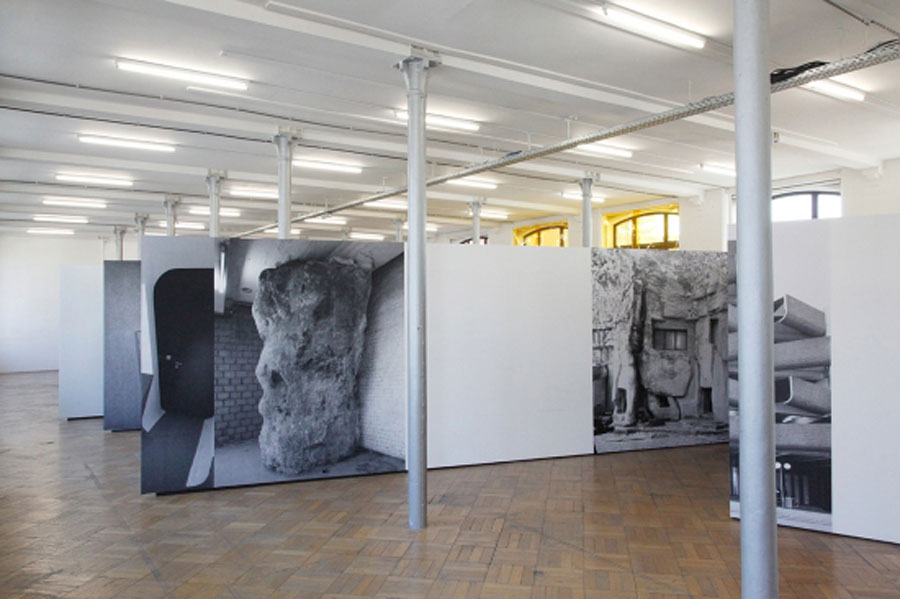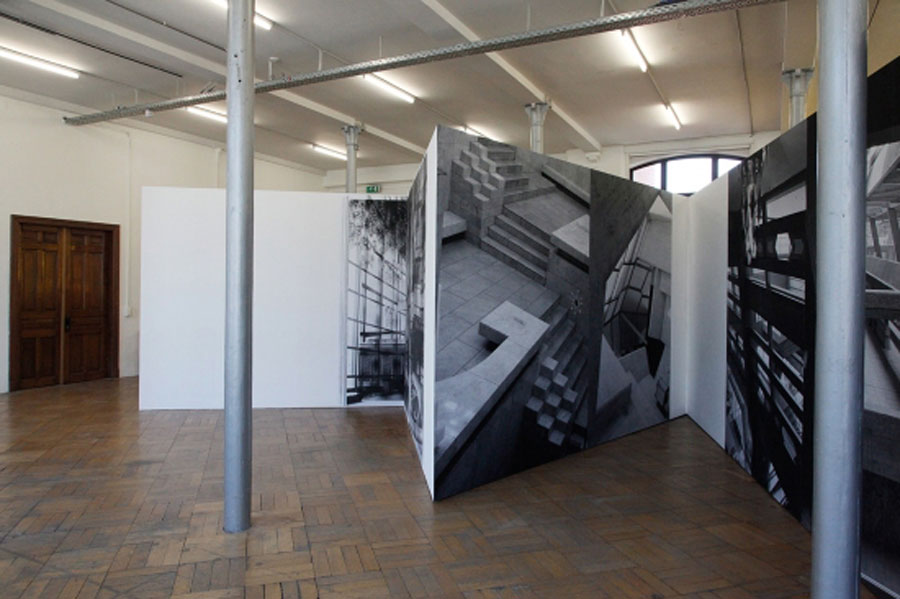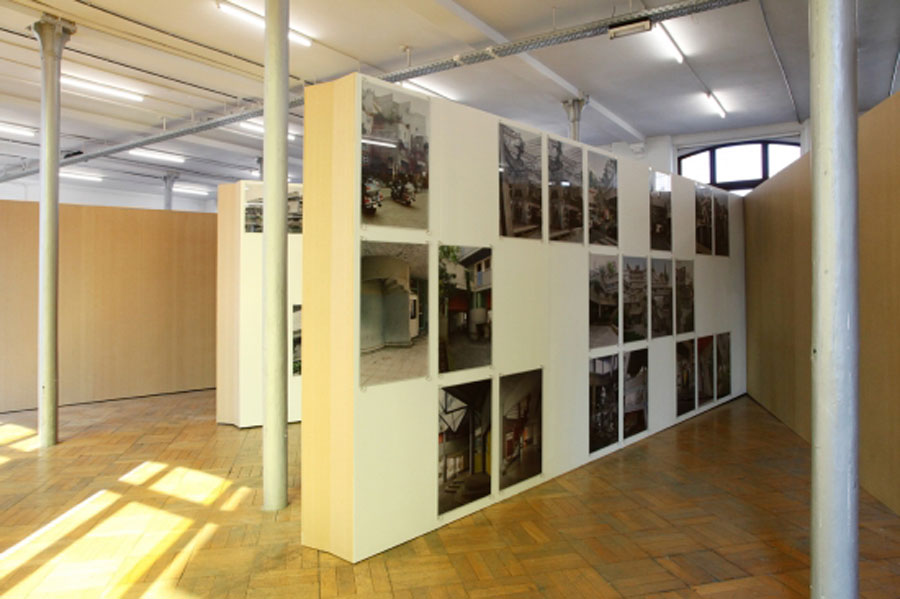Lu sur l’excellent site Le Salon, ce texte de Elke Couchez
Exhibition view Aglaia Konrad – FRAUENZIMMER at STUK, Leuven © 2013 Katrin Kamrau / www.document-architecture.com
Exhibition view Aglaia Konrad – FRAUENZIMMER at STUK, Leuven © 2013 Katrin Kamrau / www.document-architecture.com
FRAUENZIMMER
In collaboration with architect Kris Kimpe, Brussels-based artist Aglaia Konrad (°1960, Salzburg) has divided the exhibition room at STUK in two unequal parts. The high, sharp-edged wall which pierces the room consists of straight lines, diametrically opposing each other but also merging into narrow angles. These panels carry fragments of 20th century modernist buildings on the one side and brutalist structures designed by Jean Renaudie, Renée Gailhoustet and Sashio Otani on the other. For these sculptural photo-essays, Konrad has drawn from her extensive archive of images. As the exhibition Frauenzimmer interweaves and makes tangible different spheres of action, it raises inevitable questions on movement, body, sight and gender.
Embodied experience
Most stringently present in Konrads photo-essays are the modernist icons of transition: corridors, pathways, architectural junctions and highways. They give shape to an urban landscape which unfolds as a network of lines connecting isolated dots. The only way to inhabit and appropriate this landscape is by modern means of transport. Not developed for the sake of movement, the walk or slowness, these paths are purposeful conductors in the urban fabric. Regulating the mobilisation of bodies out of the logic of efficiency, these lines determine the way in which the urban landscape is perceived. Walking along Konrads panels, a contradiction becomes apparent: the body is almost absent in the photographed buildings, yet it is the measure and condition inhabiting a certain designed space. Moving across and through the panels, the constraints of the one-point perspective are overcome. With this bodily experience, a haptic dimension is added to the purely visual perception. As Patrick Healy has noticed in The Model and its Architecture, the spatial representation of architecture introduces a phenomenological realm, which transcends the dichotomy between things and inscriptions. In this micro-urban setting of modernist fragments however, movement is also guided into blind alleys. This ‘cul-de-sac-construction’ of the panels cause an impasse which leads to a distorted perspective. This way, Konrad opposes the Modernist celebration of synthesis and the idea that architecture can facilitate an organised and unified view on the world. While the ‘promenade architectural’, as conceived by Le Corbusier, ultimately leads to a unified vision on the landscape, a walk through the exhibition room results in fragmentation. This deduplicated perception corresponds with different temporalities: the time of building and inhabiting, the time of representation and the time of viewing. Konrads photographs dissect the concrete into a pixelated substance, denying the possibility of sounded representation. By doing so, she reveals the paradox of the modernist ambition: while striving for unity and synthesis, placelessness and alienation became the ultimate condition of modernist dwelling.
Areas of tension / Areas of interaction
Moreover, leading the public into different angles, Konrad reveals the imperative nature of architecture. Her panels, just like modernist architecture and infrastructure, dictate the route to be followed and thus also the sequences of viewing and interacting. Architecture consequently regulates the social: the spaces of encounter, the division of outside and inside and private and public. Konrad seems to comment on this power relations attached to architecture, more specific to the gender issues which are evoked by these relations. ‘Frauenzimmer’, the title of the exhibition, is a Middle High German word used to describe the chamber of a lady, and was later employed in a more general sense. What this exhibition brightly demonstrates is that architecture can be an instrument increasing social (gender) inequality. The highly contested 19th century writer John Ruskin, attributed to the man an active, progressive and defensive power. As discoverer and defender, he opposes the woman’s feeling for ‘sweet ordering, arrangement and decision’. He ascribed these qualities respectively to the public and the private sphere. The 20th century discourse which was built on this discrepancy between inner and outer areas of action, moreover assigned to the masculine qualities as sobriety and authenticity. The architect Henry Van de Velde, amongst others, fulminated against the deception of the eclectic façade, which did not correspond with what it kept inside. Non-functional decorative elements were moreover considered as effeminate. Harmony – which consequently was a masculine feature – was to be found in this correspondence between inside and outside: an almost Platonic idea of matching means and goals.
Tactile concrete
Aglaia Konrad plays with these distinct areas of action by focusing on constructive architectural elements. The concrete for instance, is in some photographs displayed as a partition between two spheres, and in others as a permeable substance, facilitating passage. Key piece is a photograph showing an immense rock, obstinately occupying the centre of a room. This stone serves a strict and uncompromising modernism. Some of Konrads photographed architectural structures are hard edged bunkers: armours protecting an impossible inside. As there is no passage linking the inside and outside domain, the sight is limited and is cast back by the harsh concrete of the building. Referring back to the first paragraph, there is a correlation to be made between modernist fascination for movement and transport, the range of sight and social (gender) inequality. While transitional roads exploited by modern means of transport facilitate a panoramic, almost scenographical view on the urban landscape, the architectural buildings themselves limit sight. The Renaissance painter Piero Della Francesca depicted this discrepancy between the different fields of action in his Double Portrait (1465) as he positioned the man in a panoramic landscape, and the woman in an intimate interior setting, a Frauenzimmer as it were. Sight, as a privileged and selective sense, is thus regulated by the position one is ought to be in.
While these architectural constructions seem to exist purely as shell and shield, Aglaia Konrad nevertheless accentuates their poetic dimension. When focusing on the expressive Sculpture House Project (1962), Jack Gillet realized in Liège as a challenge to Belgian postwar modernist aesthetics, Konrad attributes a very porous and tactile quality to the stone. “During the process of construction, a spontaneous organic architecture emerged, blending into its environment like a rock”, Adam Štěch wrote on this in Domus. In this architectural realization, the concrete is transformed into an almost organic and breathing substance. Both impermeable and closed it possesses masculine and feminine qualities.
Glass as the enemy of secrets
This potential of osmosis – the permeability of two distinct spheres – is also accentuated by her use of coloured glass. A yellow filter hanging in front of the window casts a warm glow in the room. During the 20th century, glass was a highly praised and contested construction material. For Paul Scheerbart, a defender of coloured glass, glass architecture could contribute to a new environment, and therefore to a new culture. In his utopian view, glass could tear open enclosed spaces. Walter Benjamin, however, emphasized in Experience and Poverty (1933) that this glass would lead to the poverty of experience: “It is no coincidence that glass is such a hard, smooth material to which nothing can be fixed. A cold and sober material into the bargain. Objects of glass have no ‘aura’. Glass is, in general, the enemy of secrets. It is also the enemy of possession.” As the concrete in Konrads photographs, glass has an ambiguous identity. It both opens up and fences off, it prolongs sight as well as it reveals the nakedness of things. Glass and concrete are ambiguous construction materials, as they reveal the Geheimnis of the home, but as well attribute to the Unheimlich feeling of dwelling in modernist architecture.
It is clear Konrad approaches all these issues incorporated by architecture – alienation, representation, movement, sight, gender – both as a fascinated observer and an active demonstrator. The spectator as well is invited to have an embodied experience: for when he is guided into the blind alleys, he really feels the limits of sight and disciplining power of architecture.
Elke Couchez
Exhibition view Aglaia Konrad – FRAUENZIMMER at STUK, Leuven © 2013 Katrin Kamrau / www.document-architecture.com
[sociallinkz]


